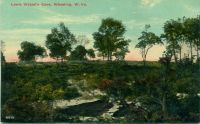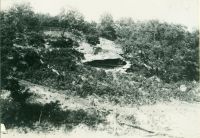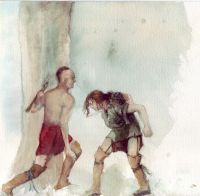
Biography: Lewis Wetzel
“The Death Wind"
Lewis Wetzel (1763-1808) is considered the greatest of all frontiersmen, scouts, and Indian fighters of the Border Wars of the Upper Ohio Valley frontier. His grandparents were immigrants from Germany, and Lewis was raised on a farm on Wheeling Creek (now Marshall County, West Virginia), 14 miles from its confluence with the Ohio.
He first gained fame at the age of 13, when he and his younger brother, Jacob, were abducted from their home and taken into the Ohio country. On the second night of their captivity the boys managed to escape and, eluding the Indians who were searching for them, they succeeded in reaching the settlement at Wheeling.
Along with his magnificent athletic abilities and amazing woodcraft, Wetzel taught himself how to load a rifle while running at full speed - no easy task when reloading a flintlock rifle. At one point he wagered that he could run faster than any man in a military company, while at the same time reloading and firing his rifle, while his competitor ran at his top speed. Wetzel won the bet.
This skill was never more necessary than in June of 1782, when he and two companions were ambushed by a large party of Indians. One of the men was killed, while Wetzel and the other, a 16-year-old boy, took to their heels. Reloading as he ran, he killed three of the pursuers, one after another, until they gave up the chase.
When Col. Benjamin Logan destroyed the Shawnee villages at Wapatomica (Logan County, Ohio) in 1786, it was Lewis Wetzel who was selected to return to Fort Harmar (Marietta, Ohio) to give the news of the expedition; he reported directly to General Harmar. He gained great notoriety in 1789 when he shot and wounded an Indian who was employed as a runner for Harmar. An incredible amount of nonsense has been written about this incident by men who have more imagination than factual information. The Indian recovered and returned to his home village, while Wetzel was released by the federal judge at Cincinnati.
After the conclusion of the Indian Wars, following Wayne's decisive victory at the Fallen Timbers in 1795, Wetzel earned a living as a hunter and trapper. He was also in great demand as a scout and guard on the many riverboats that carried produce down the Mississippi to New Orleans. Eventually he settled in Mississippi, where he contracted yellow fever in the summer of 1808. In 1941 his remains were recovered and returned to Marshall County, West Virginia, where he was re-interred in 1942.
Wetzel was never a pioneer, like Daniel Boone, but was always a scout and frontiersman. Time and time again he saved frontier settlements from disaster by giving timely warning of a projected Indian assault. In his time there was no other man more highly respected by his peers. (William Hintzen for Legendary Locals of Wheeling)
 Reference: Hintzen, William, Border Wars of the Upper Ohio Valley, 1769-1795, Manchester, CT, Precision Shooting, 1999; reprinted Ashland, KY, Jesse Stuart Foundation, 2011.
Reference: Hintzen, William, Border Wars of the Upper Ohio Valley, 1769-1795, Manchester, CT, Precision Shooting, 1999; reprinted Ashland, KY, Jesse Stuart Foundation, 2011.









 Want to keep up with all the latest Library news and events?
Want to keep up with all the latest Library news and events? 